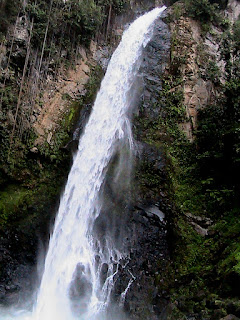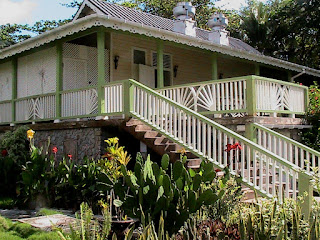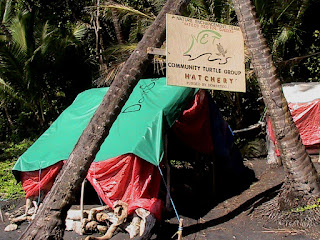After exploring the secret beaches of this rugged section of Dominica's east coast, I walked back past banks of tree ferns and a banana plantation on the winding road to Rosalie Bay.
Here, there is another stunning stretch of coastline, with a long beach bordered by palm trees and set against a background of cliffs. There was not another soul in sight.
I found a couple of wooden benches by the river and volcanic rock beach. After my morning of trekking up and down headlands to secret coves and beaches, it was a great place to just sit, relax and admire the view. I could've sat on there for hours, watching the waves and the occasional yacht passing on the horizon.
Today was a calm day, but, even so, steep breakers crashed on-shore (I swam instead in the clear and gently-flowing river, which was great- totally refreshing and cleansing).
I loved the silhouette formed by the palm trees.
Behind the beach and set within tropical gardens, is
Rosalie Bay Nature Resort.
I was greeted by Cindy, a friendly receptionist from the local village of Grand Fond, who showed me around. Rosalie Bay opened a few months ago she explained to me, and it is the only resort of its kind in Dominica (which tends to have small guesthouses and boutique hotels).
In its large gardens, Rosalie Bay Nature Resort has 28 elegantly furnished rooms and suites in private cottages. In the photo below are the garden view rooms, near the pool and gym, and with partial views of Rosalie river. In the background is a wind turbine, which provides much of the electricity for the resort. It was a huge investment and commitment for the owners- having to ship it in specially and then get it across the island's mountainous interior before assembly. For the resort, environmental protection is a priority.
Overlooking the sea and river, I was shown beautiful and luxurious Riverside, Oceanfront and Deluxe Oceanfront suites. Each has tons of space, a huge four-poster bed, marble bathroom with shower and bathtub and lounge area with hardwood furniture. Balconies have views of either the river or sea. Rooms also have wifi, flat-screen televisions and MP3 docking stations for those who want to keep in touch with the outside world.
One could, of course, easily choose to ignore all the latest technology in a place like this- I would be spending all my time outdoors and using Rosalie Bay as my base for exploring the island. And, if I was staying in the Deluxe Oceanfront suite, I would also be spending time in the Jacuzzi Air Bath to soothe those sore hiking legs! For anyone staying, the resort also has its own spa and masseur.
I would also spend time here, by the pool, with a good book.
In the background is the peak of Morne Trois Pitons, one of the highest mountains on the island, and a must for serious hikers. The resort can organise guided tours all around the island, but even within a stone's throw it's possible to have a garden tour, bird-watch, see turtles come onshore at night to lay their eggs, or use kayaks on the Rosalie river. And for those interested in cooking, there are classes available to learn how to make local creole dishes.
Beyond the pool is Zamaan's restaurant and bar, situated by the beach and river. I love the way it has been built in the style of a Dominican country house.
This is the island-style bar inside Zamaan's.
Returning to the beach at the far end of the resort, I saw that it was composed of pure volcanic sand.
At the end, where beach meets cliff, trees have been shaped by the steady onshore wind.
Above the high tide mark and under some palms, I went to check out a couple of tents. They are used as turtle hatcheries, set up in a joint turtle conservation project between Rosalie Bay Nature Resort and the local community.
Leatherback, Hawksbill and Green turtles come ashore at night in the April-September egg-laying season, and Rosalie Bay is one several beaches on the east coast of Dominica where this happens. So, for those staying in the resort at this time of year, it's an opportunity not to miss.
Here, a huge leatherback turtle is being measured.
It had laid eggs too close to the water, so to ensure that turtles hatch from them, they were transferred further up the beach, behind a fenced-off area. By such actions and with an education project in place, numbers will begin to recover to their original state (which, over the years, had been diminished by hunting).
Here, you can see just how large Leatherbacks are.
Rosalie Bay really is an idyllic place, with its volcanic beach, clear river, tropical gardens, mountain views, stunning eastern coastline and ample opportunities to explore the island and nature-watch.
For those wanting to stay here, Rosalie Bay Nature Resort is a great option.
In April 2011, the resort was offering grand opening special rates:
US$185 for Garden View Rooms
US$250 for Garden/Oceanview Suites
US$350 for Oceanfront and Riverside Suites
US$450 for the Oceanfront Deluxe Suite.

























































